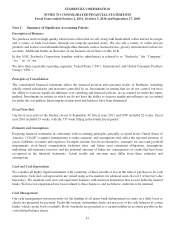Starbucks 2011 Annual Report Download - page 46
Download and view the complete annual report
Please find page 46 of the 2011 Starbucks annual report below. You can navigate through the pages in the report by either clicking on the pages listed below, or by using the keyword search tool below to find specific information within the annual report.As a part of our ongoing operations, we may close certain stores within a reporting unit containing goodwill due to
underperformance of the store or inability to renew our lease, among other reasons. We abandon certain assets
associated with a closed store including leasehold improvements and other non-transferrable assets. Under GAAP,
when a portion of a reporting unit that constitutes a business is to be disposed of, goodwill associated with the
business is included in the carrying amount of the business in determining any loss on disposal. Our evaluation of
whether the portion of a reporting unit being disposed of constitutes a business occurs on the date of abandonment.
Although an operating store meets the accounting definition of a business prior to abandonment, it does not
constitute a business on the closure date because the remaining assets on that date do not constitute an integrated set
of assets that are capable of being conducted and managed for the purpose of providing a return to investors. As a
result, when closing individual stores, we do not include goodwill in the calculation of any loss on disposal of the
related assets. As noted above, if store closures are indicative of potential impairment of goodwill at the reporting
unit level, we perform an evaluation of our reporting unit goodwill when such closures occur.
During the past three fiscal years, we have not made any material changes in the accounting methodology that we
use to assess goodwill impairment loss. For fiscal 2011, we determined the fair value of our reporting units was
substantially in excess of their carrying values. Accordingly, we did not recognize any goodwill impairments during
the current fiscal year. We do not believe there is a reasonable likelihood that there will be a material change in the
estimates or assumptions that we use to test for impairment losses on goodwill in the foreseeable future. However, as
we periodically reassess our fair value calculations, including estimated future cash flows, changes in our estimates
and assumptions may cause us to realize material impairment charges in the future.
Stock-based Compensation
We measure the fair value of stock awards at the grant date based on the fair value of the award and recognize the
expense over the related service period. For stock option awards we use the Black-Scholes-Merton option pricing
model which requires the input of subjective assumptions. These assumptions include estimating the length of time
employees will retain their stock options before exercising them (“expected term”), the estimated volatility of our
common stock price over the expected term and the expected dividend yield. In addition, we are required to estimate
the expected forfeiture rate and only recognize expense for those stock awards expected to vest. We estimate the
forfeiture rate based on historical experience. Changes in our assumptions could materially affect the estimate of fair
value of stock-based compensation.
We do not believe there is a reasonable likelihood that there will be a material change in the estimates or
assumptions that we use to calculate stock-based compensation expense for the foreseeable future. However, if
actual results are not consistent with our estimates or assumptions, we may be exposed to changes in stock-based
compensation expense that could be material in the future. For fiscal 2011, a 10% change in our critical
assumptions, including volatility and expected term, would have changed stock-based compensation expense by
approximately $15 million for fiscal 2011.
Operating Leases
We lease retail stores, roasting and distribution facilities and office space under operating leases. We provide for an
estimate of our asset retirement obligation (“ARO”) at the lease inception date for operating leases with
requirements to remove leasehold improvements at the end of the lease term. Our estimates of AROs involve
assumptions regarding both the amount and timing of actual future retirement costs. The initial ARO asset and
liability represent the present value of the estimated future costs to complete the required work. The ARO asset is
depreciated over the same timeframe as the associate leasehold improvements, and the liability is accreted over time.
Future actual costs could differ significantly from amounts initially estimated.
We occasionally vacate stores and other locations prior to the expiration of the related lease. For vacated locations
with remaining lease commitments, we record an expense for the difference between the present value of our future
lease payments and related costs (e.g., real estate taxes and common area maintenance) from the date of closure
through the end of the remaining lease term, net of expected future sublease rental income. Key assumptions in our
40
























